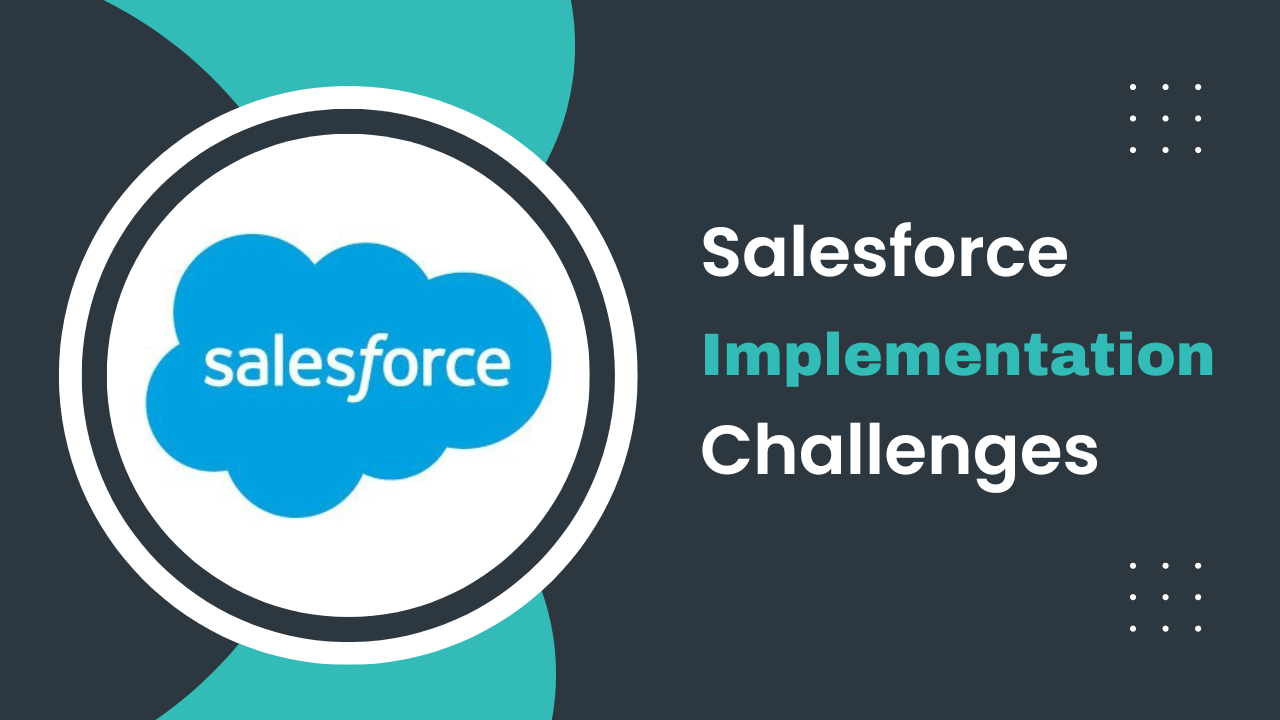Top 7 Most Common Salesforce Implementation Challenges
 Udit Handa
Udit Handa
Salesforce implementation can prove to be a complex task, as it harbors the potential for various pitfalls. According to the official Salesforce Blog, 71% of endeavors to integrate the Customer Relationship Management (CRM) platform culminate in disappointment. So, what contributes to the nature of this task?
Within this article, we will include the five most prevalent trials that organizations encounter during Salesforce implementation. Furthermore, we will provide insights on sidestepping these stumbling blocks and present optimal methodologies that can propel your organization toward triumph in its Salesforce journey.
Primary Challenges in Salesforce Implementation
Salesforce integration within a business can take various roadmaps. Certain entities opt for independent execution, some enlist the aid of freelancers, while many prefer to engage a Salesforce implementation consultant for comprehensive oversight (a highly advisable course of action). Yet, without meticulous pre-implementation preparation, there's a potential of adopting a solution that falls short of business requisites and objectives.
Before embarking on the project, let's examine prevalent hurdles encountered by users during Salesforce implementation. This exploration will facilitate a swift resolution of these matters, ensuring a seamless and triumphant deployment.
Navigating Implementation Challenges
Once you've identified the ideal collaborator, the next step entails delving into the execution of the new software. Implementing a CRM solution presents its share of complexities, primarily stemming from the extensive array of functionalities and tools encompassed within a single platform.
Within this vast toolkit, not all features will align with your specific business context, investing in superfluous capabilities lacks merit. Here, customization assumes paramount significance, affording you the latitude to cherry-pick functionalities that directly contribute to your company's growth.
Overcoming Challenges in Integrating Salesforce
The integration of Salesforce into your company's existing software ecosystem and third-party systems introduces a set of potential challenges. The objective is to establish a seamless relationship between Salesforce and other tools employed within your organization. This symbiotic exchange of valuable data and supplementary functionalities is key.
Collaborating with your partner to formulate a robust integration strategy becomes crucial, especially when determining the relevance of any pre-existing software post-Salesforce implementation. This assessment is particularly dependent on paid tools, ensuring resource allocation and avoiding redundant expenses for functionalities already encompassed by the new CRM.
Addressing Data Mapping
Data mapping presents itself as a significant challenge during Salesforce integration. The process of aligning data across the Salesforce CRM and other applications often unveils discrepancies and mismatches in data fields. Such frequently arise of issues due to variations in field types across different applications. For instance, while Salesforce may utilize distinct fields for components of an address (street name, city, state, etc.), alternative applications might employ a different field structure for addresses.
This divergence in field types can result in challenges when coding and mapping data. When executing data and field mapping, it is imperative to ensure accurate field type mapping. A best practice involves converting data into formats supported by the targeted application's fields, thus averting data mismatches.
Ensuring Accurate Data Migration
During the implementation journey, Salesforce experts face significant challenges that revolve around precisely mapping data between systems, both into Salesforce and back out from it. The quality of this data holds much importance, as the efficacy of your CRM platform hinges on its accuracy. Inaccurate or incomplete data can lead to distorted analytics, the proliferation of duplicate records, inconsistencies, and an increased financial burden to rectify these issues.
Moreover, the Financial Services sector generates substantial volumes of data daily, emanating from diverse sources. Filtering and deciphering data holds value, and becomes a task for companies in this domain.
A successful migration lies in the accuracy of data transition from one platform to another. In this pursuit, it's imperative to discern the specific data requirements within Salesforce. By instituting robust data validation metrics, you lay the groundwork for a seamless data migration that guarantees the integrity and usefulness of your CRM system.
Tailoring to Business Needs
Aligning your platform with the distinctive demands of your business might necessitate a degree of customization. Salesforce boasts remarkable flexibility in this regard. Yet, the path to customization can be intricate and resource-intensive, contingent on the nature of your business and industry.
Lack of User Adoption
Within the realm of Salesforce implementation, a prominent challenge lies in securing user embrace of the system. Users, entrenched in their established ways of operation, frequently exhibit reluctance toward adopting a new system. The perceived benefits of transitioning to Salesforce might not be immediately apparent to them, and the perceived complexity of the system could further discourage their buy-in.
To foster user adoption, several strategies can be employed:
Highlight the Benefits: Illuminating the advantages of Salesforce to users is paramount. Demonstrating how the system streamlines processes, enhances efficiency, and bolsters results can galvanize their interest.
Prioritize User-Friendly Design: Keeping the system user-friendly is vital. A well-designed interface and intuitive navigation can alleviate apprehensions and expedite acclimatization.
Offer Comprehensive Training: Guiding users through the system's functionalities via structured training can build competence and confidence. This diminishes the likelihood of resistance due to unfamiliarity.
Provide Responsive Support: Establishing a supportive environment where users can seek assistance when needed cultivates a sense of security. Addressing their concerns promptly reinforces their trust in the system.
By meticulously addressing these considerations, the journey toward robust user adoption can be significantly smoothed.
Elevating Security Measures
With Salesforce's comprehensive security features, enterprises encounter potential obstacles in upholding data and system integrity. An instance of this arises from insufficient authentication and access controls, often precipitating unauthorized entry or the improper handling of confidential data.
Doing comprehensive training of your staff in security and learning the best practices and strategies to mitigate data breach risks on the Salesforce platform helps to ensure the safeguarding of sensitive customer data.
Wrapping Up
Whether you're facing CRM challenges, we've outlined a capable ally for your Salesforce implementation, consider our CRM experts as your solution. Our team of seasoned Salesforce experts is quite capable to provide comprehensive support throughout these processes. Drawing years of experience, we specialize in maximizing the value of CRM investments, and we're excited to extend our proficiency to your venture.
Reach out to our team to initiate a conversation about your project. Together, we'll devise strategies to preempt any potential Salesforce setbacks, both immediately and down the line. Your seamless Salesforce journey starts here.
Subscribe to my newsletter
Read articles from Udit Handa directly inside your inbox. Subscribe to the newsletter, and don't miss out.
Written by

Udit Handa
Udit Handa
I am the CEO of Cynoteck Technology Solutions. We are Specialized in CRM Development & Implementation, Dynamics 365 CRM, Salesforce Development, Mobile app development, Artificial Intelligence, Web application Development, and Digital marketing.